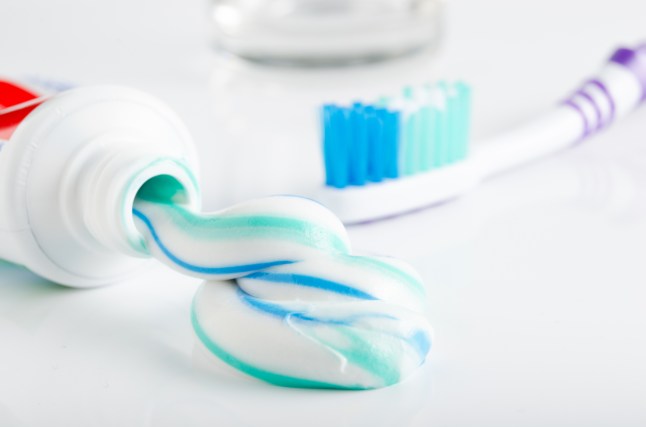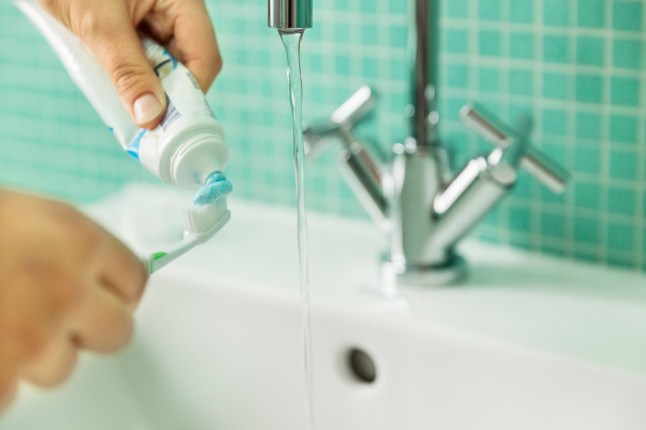20 Nov, 2025 | Admin | No Comments
Shoppers are losing it over the ‘flipping ridiculous’ £23 cost of daily essential


‘This can’t be f**king real. Eight f**king pound ten for some toothpaste,’ a disgruntled mum shouted into her phone in the supermarket.
Next to it, you can find a standard sized 75ml tube of Colgate Max White Ultimate Whitening Toothpaste for £23.
For reference, that money could buy you four rump steaks from Waitrose, a 5.99kg whole turkey from Sainsbury’s, or a flight to Marrakech with £8 left to spend.
And Colgate isn’t the only brand with pricey paste. If you opt for Oral-B’s Pro Science Clinical Intensive Clean Toothpaste, it’ll set you back £10, as will Sensodyne’s Clinical Repair.
Shoppers are becoming increasingly incensed, taking to TikTok claiming the basic toiletry is being made a ‘luxury item’.
To rub salt in the wound, consumer watchdog Which? recently revealed the oral hygiene product was one of the biggest culprits for shrinkflation, with the price per 100ml rocketing by 105%.
For example, Aquafresh’s Complete Care Original Toothpaste climbed in price from £1.30 to £2, but the amount fell from 100ml to 75ml.

‘What is going on in the world today? £8 for toothpaste, this is flipping ridiculous. Something needs change man, that’s crazy work,’ ranted TikToker Petal.
‘I think they’re going to have to start doing disposable teeth so we don’t have to brush them,’ shared Lynn.
Another said: ‘What in the cost of living crisis is this? £6 for toothpaste – that’s blown my mind.’
Consumer champion Martin Newman can see why shoppers are disgruntled, telling Metro: ‘We’ve crossed a line when the cost of brushing your teeth feels like a privilege rather than a basic hygiene routine.
‘Should it cost £8 to brush your teeth? Absolutely not. That’s a symptom of a market that’s lost touch with the consumer reality many households face.’
Why is toothpaste so darn expensive?
Put simply, Martin explains prices have surged because of three main reasons: inflationary pressure, supply chain costs, and premiumisation.
‘The cost of ingredients, transport, packaging, and marketing has all gone up in the last two years, and big brands have passed much of that onto consumers,’ he says.
‘At the same time, brands have become very good at “premiumising the basics” — convincing us that we need whitening technology, enamel repair, or charcoal cleansing to get a better result. What used to be a £2 essential is now sold as a £6–£8 science-driven solution.’
Now, you could argue that Colgate’s £23 tube of whitening toothpaste must have extra special ingredients in that warrant that price tag, but dentist Dr Sulaman Anwar, Specialist Periodontist and Implant Surgeon of Serio Dental, disagrees.

‘They key additions are sodium polyphosphate, potassium citrate, and a blend of more refined hydrated silica polishing agents,’ Dr Anwar tells Metro.
For those without a dentistry degree, Dr Anwar explains that ‘polyphosphates are commonly used in whitening products because they help disrupt how stains attach to the tooth surface.
‘Potassium citrate is included as a desensitising agent for people who experience sensitivity.
‘The silica particles provide polishing, and in higher-priced toothpastes these particles tend to be more uniform and designed to remove stains more gently.’
It sounds pretty advanced, but Dr Anwar explains, while these ingredients elevate the formulation above basic budget toothpastes, they aren’t exclusive or unusual within the wider whitening category.
‘In my professional view these ingredients don’t justify the £23 price tag,’ he adds. ‘While the ingredients are effective in supporting stain removal, they are not significantly different from what you would find in many whitening toothpastes priced far lower.
‘The cost reflects branding, marketing, and the “at-home whitening” positioning, rather than a genuinely superior or advanced formula.’
But brushing our teeth sadly isn’t something that can be avoided (as much as we might wish we could) so brands can push up the price without losing too many sales.
It’s a tough pill to swallow when more than 7 million low-income families are going without essentials in 2025, according to the Joseph Rowntree Foundation.
Not to mention financial hardship is likely to deepen as disposable incomes, after housing costs, are projected to fall by £690 by 2030.
They bank on our ‘consumer inertia’, which Martin explains is the assumption we won’t take the initiative and switch brands. But that trend can’t continue forever.
‘I think we’re nearing consumer pushback territory — people will start trading down to supermarket own-labels or discount brands, which often perform just as well for a fraction of the price,’ Martin adds.
At the end our two minute teeth brushing, Martin says it all comes down to this: ‘Value isn’t always about price — it’s about fairness.
‘Consumers are willing to pay for genuine innovation or sustainability, but not for marketing spin on basic needs.’
Metro has contacted Colgate for comment.
Do you have a story to share?
Get in touch by emailing MetroLifestyleTeam@Metro.co.uk.
19 Nov, 2025 | Admin | No Comments
Christmas outfits you can rotate and repeat with 5 capsule wardrobe pieces

What to wear at Christmas events can seem overwhelming, but all you need are five key pieces to look great at Christmas parties. Check out our professional stylists’ tips.
19 Nov, 2025 | Admin | No Comments
Kelly Brook’s most iconic bikini moments that will go down in history

I’m A Celebrity, Get Me Out of Here star Kelly Brook always looks stunning in a bikini – here are her best bikini moments from her modelling days and beyond
19 Nov, 2025 | Admin | No Comments
Princess Kate stops traffic in Talbot Runhof green velvet dress at Royal Variety Performance

The Princess of Wales looked stunning at the Royal Variety Performance 2025. Prince William’s wife wore an emerald green velvet dress and high heels by Talbot Runhof.
19 Nov, 2025 | Admin | No Comments
Line of Duty star Vicky McClure’s Nottingham home that ‘goes against the grain’

Get all the details on Trigger Point actress Vicky McClure’s home, where she will unwind from filming the newly announced season seven of Line of Duty, starring Martin Compston and Adrian Dunbar.
19 Nov, 2025 | Admin | No Comments
Our four-year-old was diagnosed with brain cancer — then I found a lump


Raffi Starkowitz’s parents describe their little be as ‘cheeky, funny, and kind.’
Like lots of four-year-olds, he loves playing with his trains and cars, and kicking balls around.
But in March 2025, Raffi began walking differently.
‘We thought his walking unsteadily was strange, but nothing out of the ordinary,’ Raffi’s parents, Nikki, 46, and Neil, 47, explained.
The couple, from Barley, Hertfordshire, were with their two older daughters, Ella, 10 and Talya, seven, when they first got a call from Raffi’s nursery about his wobbliness — with staff saying he was leaning heavily to one side.

So, they took Raffi to the GP, who was unsure over what was causing the four-year-old’s walking problems, and referred him to A&E.
‘There, Raffi had a blood test that came back normal,’ the pair noted. But still worried, they showed the doctor a video of Raffi walking normally.
‘That is when the doctor recommended an MRI scan. Then things went downhill quickly,’ they shared.
With Nicky being a nurse herself, so was able to quickly pick up on the fact that the doctors likely suspected Raffi was in trouble.
‘When I was in the MRI room with Raffi, they came in halfway and gave him contrast [a dye that makes certain areas on a scan show up more clearly].
‘As a nurse, I knew that you only give contrast when you see something on the scan,’ she explained. ‘From that point, I knew it was something serious.’
And, five days later, Nicky and Neil were delivered the devastating news: their four-year-old son had a brain tumour.

‘When we got the news, we felt like someone had punched us in the chest and knocked all the wind out of us,’ the couple shared.
‘Nothing prepares you for the moment you are told that your child has cancer.’
Nicky and Neil couldn’t believe how quickly their son went ‘downhill,’ especially given that it’d only been a week since Raffi’s unsteadiness was spotted at nursery.
The doctors immediately jumped into action, with Raffi undergoing a 10-hour operation to remove the tumour at Great Ormond Street Hospital, which thankfully proved to be a total ‘success.’
‘They were able to remove the whole mass and not leave anything inside,’ Neil says.
However, following Raffi’s two initial rounds of chemotherapy, doctors found that the cancer had spread.
It was naturally an incredible scary time for the family and Raffi immediately started six weeks of radiotherapy in June 2025. The side effects were brutal for the little boy, who dealt with sickness, fatigue, skin peeling and hair loss.
Thankfully, by September, further scans revealed that there were no longer any visible signs of disease.
Nicky said: ‘When his scan came back clear, that was the best news we could have hoped for. He had responded to the treatment, which was a massive relief for us.’
‘It was an amazing moment; it gave us hope and something to grasp onto.’

For this family, however, their struggles weren’t over yet.
Five months after Raffi’s diagnosis and treatment, Nicky discovered an unusual mark on her breast, and was later diagnosed with stage three breast cancer.
The mum had three tumours, and underwent a mastectomy and complete reconstruction.
To combat this, the 46-year-old is currently receiving six months of chemotherapy, which will then be followed by radiotherapy and hormone treatment.
But for both Nicky and Neil, their focus is still their son, as the risk of relapse is sadly very high for the type of cancer Raffi had.
‘Luckily, there is a huge amount of treatment available for me, but for Raffi there is not,’ Nicky explained. And while his current scans show no visible disease, there’s a high risk the cancer could return.
So, with no preventative treatments currently available in the UK, the couple have shifted their sights to across the pond.
In the US, some children’s hospitals are trialling a new drug, difluoromethylornithine (DFMO), to treat high-risk medulloblastoma. Raffi’s parents wrote to ‘every hospital in America’ that is taking part in this trial to try and get their son a place.
Penn State Children’s Hospital, in Pennsylvania, replied, and offered Raffi a place.

Nicky and Neil have created a GoFundMe and are now in the process of trying to raise £300k to cover the cost of any ‘treatment, travel insurance, accommodation, and any future medical needs.’
So far, the pair have reached more than £200,000. On their GoFundMe, Nikki and Neil thanks their supporters ‘from the bottom of our hearts’, adding: ‘You have given our little boy a real chance at life, and we will never forget it.’
DFMO is currently only used to treat high-risk neuroblastoma in the UK and has not yet been approved by regulatory bodies for use on other rare cancers. So, this feels a lot like the family’s best chance at getting Raffi the care he needs.
Hopeful for the future, Nicky and Neil are aiming to ‘head out there at the end of January 2026 to meet the team.’
They are continuing to raise money to support Raffi in his health journey.
‘We are now raising our target to help fund these long-term needs, cover future scans and care, and ensure we can access any new or emerging treatments or clinical trials that may offer him the best possible future.
‘Thank you for standing with Raffi and our family, and for helping us fight for his tomorrow,’ the shared.
Do you have a story to share?
Get in touch by emailing MetroLifestyleTeam@Metro.co.uk.
19 Nov, 2025 | Admin | No Comments
It’s a romantic secret we’ve been sharing with animals for 21.5 million years

A new study has revealed that the first kiss was shared over 21.5 million years ago. And it’s not just humans who love a smooch…
19 Nov, 2025 | Admin | No Comments
Lady Kitty Spencer is a rebellious royal in ‘naked’ Christmas dress

Princess Diana’s niece, Lady Kitty Spencer, looked stunning at a Dolce & Gabbana event, wearing a black lace, see-through dress that showed off her VPL.
19 Nov, 2025 | Admin | No Comments
Queen Letizia’s subtle message of ‘strength and stamina’ in shimmering sequin skirt

Queen Letizia of Spain went for a gorgeous high-street look for the Journalism Awards at Hotel Ritz on Tuesday, opting for a bold sequin skirt and accessories
19 Nov, 2025 | Admin | No Comments
How to prevent car windows freezing – with 2 unexpected household items

Forget expensive, de-icing fluid and other fancy methods to rid your windshield of frost and reach inside your kitchen cupboard instead for onions and vinegar, as they’ll help prevent the cold from ruining your morning commute